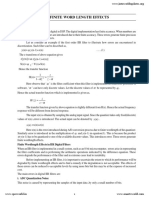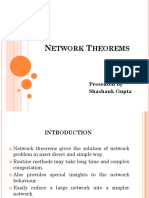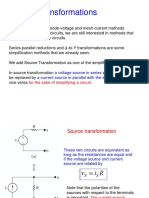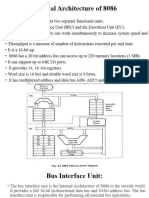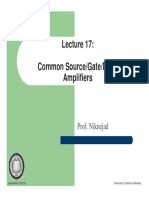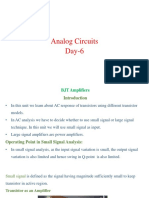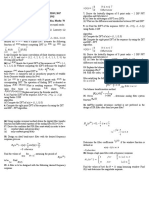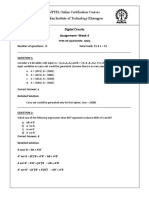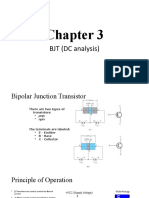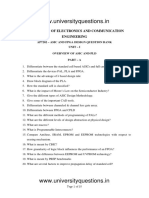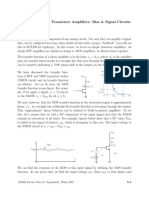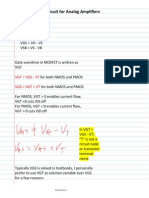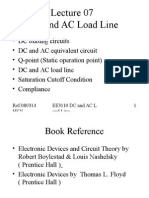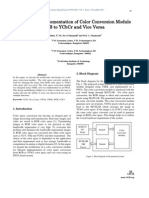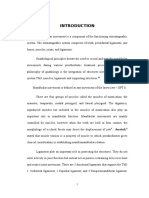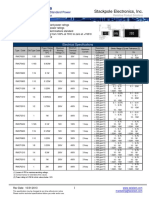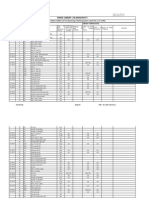2.
MOS: Transfer Function, Bias, and
Small Signal Model
Reading: Sedra & Smith: Secs. 5.4 & 5.5
(Also see Sec. 4.3.7)
ECE 102, Winter 2011, F. Najmabadi
�NMOS Characteristic Equations
PMOS
For PMOS: vGS vSG, vDS vSD, vtn |vtp|, kn kp, and iD flowing OUT of the drain
�NMOS Transfer Function
For vGS < Vtn , NMOS is in cutoff:
�NMOS Transfer Function
o For vGS > Vtn
as
vGS
iD
vDS
o (NMOS in saturation as we started with vDS = VDD > vGS Vtn )
o iD and vDS can be found from
�NMOS Transfer Function
o As vGS increases vDS becomes smaller until at point B where vDS = vGS Vtn .
o For larger vGS NMOS is in triode
Exercise: Find VGS|B and VDS|B
�NMOS Transfer Function
�A combination of constant VGS and a signal (vgs)
Bias
Bias
�A combination of constant VGS and a signal (vgs)
Bias and signal
Bias
Bias and signal
�Response to the signal appears to be linear!
Bias and signal
�A linear transfer function for the Signal!
vds
Signal and
response
vGS = VGS + vgs
vDS = VDS + vds
iD = IDS + id
Bias
vgs
�An Analogy
Response
hb
Added Weight
(signal)
Boat
Hb = HB
Pool
Bias
HB
Hb
Bias + signal
Total Height, Hb = Bias (HB) + response to signal (hb)
Complicated correlation between total height, Hb , and weight
of the boat.
Simple correlation between hb and added weight
�hb
Added Weight
(signal)
HB
Hb
Bias + signal
Bias: HB
Bias + Signal: Hb
Signal &
response to signal: hb
Bias: VGS , VDS , ID , VRD
Bias + Signal: vGS , vDS , iD , vRD
Signal &
response to signal: vgs , vds , id , vrd
Non-linear correlations among Bias + Signal: vGS , vDS , iD , vRD
Simple (and linear) correlation between signal and response to the
signal: vgs , vds , id , vrd
�Important Points!
Signal: We want the response of the circuit to this input.
Bias: State of the system when there is no signal (current and
voltages in all elements).
o Bias is constant in time (may vary extremely slowly compared to
signal)
o Purpose of the bias is to ensure that MOS is in saturation at all times.
Response of the circuit and elements within to the signal is
different that the response of the circuit and its elements to
Bias (or to Bias + signal):
o Different transfer function for the circuit
o Different iv characteristics for the elements, i.e. relationships among
vgs , vds , id is different than relationships among vGS , vDS , iD .
�Limitations and Constraints
Floating Boat analogy
Boat should float at all
times!
o Sufficient water in the pool
Transistor
MOS should be in saturation
at all times!
o Bias point in Saturation*
VGS > Vtn
VDS > VGS - Vtn
o Cannot put too much weight
(depends on the depth of the
water!)
o Signal amplitude cannot
become too large (depends
on Bias point!)*
vGS = VGS + vgs > Vtn
vDS = VDS + vds > VGS + vgs- Vtn
* Equations are for NMOS!
�Procedure:
1. How to establish a Bias point (bias is the state of the
system when there is no signal).
o
Stable and robust bias point should be resilient to variations in k,
Vt , due to temperature and/or manufacturing variability.
2. Find the iv characteristics of the elements for the signal
(which can be different than their characteristics equation
for bias).
o
This will lead to different circuit configurations for bias versus
signal
3. Compute circuit response to the signal
o
Focus on fundamental MOS amplifier configurations
�BIAS
(Ensure that MOS is in saturation at all times,
Important parameters are ID and VDS )
�Bias with Gate Voltage
ID = 0.5 kn (W/L) (VGS Vtn)2
VDS = VDD RD ID
This method is NOT desirable as k, Vt , are not well-defined
as bias point (i.e., ID and VDS) can change due to temperature
and/or manufacturing variability.
o See Exercise 5.33
�Bias with Source Degeneration
Basic Arrangement
VGS = VG RS ID
Bias with one power supply
Bias with two power supplies
VGS = VG RS ID
VGS = VSS RS ID
(KVL: 0+ VGS + RS ID VSS = 0)
Resistor Rs provides negative feedback
�Resistor Rs provides negative feedback
VGS = VG RS ID
ID = IS = 0.5 kn (W/L) (VGS Vtn)2
Negative Feedback:
o If ID (because kn or Vtn )
o If ID (because kn or Vtn )
Basic Arrangement
VGS Eq.
VGS Eq.
VGS
VGS
ID Eq.
ID Eq.
ID
ID
Feedback is most effective if RS ID >> VGS as
0 = VGS + VG RS ID VG RS ID
or ID VG /RS
�Example: Find Bias point for Vt =1 V, k W/L = 1 mA/V2
VG = (7)/(7+8) X 15 = 7 V
GS-KVL: VG = VGS + RS ID
VG = 7 V
VD = 10 V
ID = 0.5 kn (W/L) (VGS Vtn)2
VS = 5 V
VGS = 2 V , VS = VG VGS = 5 V
7 = VGS + 5 (VGS 1)2
DS-KVL: 15 = VDS + (RS + RS )ID
VDS = 5 V , VD = VS + VDS = 10 V
Impact of RS:
if Vt = 1.5 V (50% change), ID = 0.455mA (9% change)
�Bias in ICs
Resistors take too much space on the chip
A robust bias has ID and VDS that do not change. One can
force ID to be constant using a current source.
ID = I
VG = 0
VD = VDD RD ID
VGS is set by
I = ID = 0.5 kn (W/L) (VGS Vtn)2
VS = VG VGS = VGS
VDS = VD VS
�Current Mirrors (or Current Steering Circuits)
Identical MOS:
Same kn and Vt
Since VGS1 = VGS2 = VGS :
Circuit works as long as Q2 is in saturation
VDS2 > VGS - Vt
Q1 is always in saturation
VDS1 = VGS > VGS - Vt
�An implementation of a Current Mirror
Identical MOS:
Same kn and Vt
Bias point of Q1 is uniquely set by:
Since VGS1 = VGS2 = VGS :
Circuit works as long as Q2 is in saturation
VDS2 > VGS - Vt
�Examples of Current Steering circuits
Current steering circuit can bias several transistors
A PMOS current mirror
�An implementation of current steering
circuit to bias several transistors in an IC
�SMALL SIGNAL MODEL
2.
Find the iv characteristics of the elements for the signal (which can be
different than their characteristics equation for bias).
This will lead to different circuit configurations for bias versus signal
�Signal-only circuit is different!
Bias
VDD: VDD
R D:
VRD
IRD = ID
Signal only
MOS: VGS, ID, VDS
Bias and signal
No signal here!
VDD: VDD
RD:
vRD = VRD + vrd
iRD = iD = ID + id
MOS: vGS = VGS + vgs
vDS = VDS + vds
iD = ID + id
RD:
vrd
ird = id
MOS: vgs, id, vds
�Signal Model for linear circuit elements
Independent voltage source (e.g., VDD)
o No signal: effectively grounded
Independent current source
o No signal: effectively open circuit (Careful about current mirrors as they
are NOT ideal current sources, channel width modulation was ignored!)
Resistors, capacitors, inductor
o Remain the same:
Dependent sources
iR =
vR =
vR =
vR =
vr =
IR + ir
VR + vr = RIR + vr
R iR = R (IR + ir ) = RIR + R ir
RIR + vr = RIR + R ir
R ir
o Remain the same with the control parameter related to the signal!
Non-linear Elements:
o Different!
�Diodes: signal response is non linear but can be
linearized when signal is small
vD
iD
vd
VD
ID
id
vd
id
R = nVT/ID
�Formal derivation of small signal model
XA
x A = X A + xa
YA = f ( X A )
y A = f ( xA )
xA
f()
YA
f()
y A = YA + y a
g()
yA
( 2)
f
(X A)
2
(1)
= f ( X A ) + f ( X A ) (x A X A ) +
( x A X A ) + ...
2!
( 2)
f (X A) 2
(1)
= f ( X A ) + f ( X A ) xa +
xa + ...
2!
f ( X A ) + f (1) ( X A ) xa
Small signal means:
( 2)
f
(X A) 2
(1)
(1)
f ( X A ) xa >>
xa
y a = g ( xa ) = f ( X A ) xa
2!
f (1) ( X A )
xa << 2 ( 2 )
f (X A)
�Derivation of diode small signal model
nVvD
iD = I S e 1
VD
nV
I D = f (VD ) = I S e T 1
nV
IS e T
(1)
id = f (VD ) vd =
nVT
nVx
f ( x) = I S e T 1
VD
nV
IS e T
vd =
nVT
x =VD
ID + IS
vd = nV vd
T
ID
ID + IS
id =
vd
vd
nVT
nVT
vd
id =
rD
nVT
rD
ID
vd
id
R = nVT/ID
�Derivation of MOS small signal model
x A = X A + xa
xA
yA
y A = YA + y a
z A = f ( xA , y A )
XA
Z A = f ( X A , YA )
YA
f(, )
zA
f(, )
ZA
za = z A Z A
z A = f ( xA , y A )
= f ( X A , YA ) +
f ( x, y )
x
f ( x, y )
ZA +
x
( xA X A ) +
X A ,YA
f ( x, y )
xa +
y
X A ,YA
f
za =
x
f
xa +
y
X A ,YA
f ( x, y )
y
ya
X A ,YA
ya
X A ,YA
( y A YA ) + ...
X A ,YA
�Derivation of MOS small signal model
iG = 0
iD = 0.5 kn (W/L) (vGS Vtn)2 (1 + vDS) = f (vGS , vDS)
iD = f (x, y)
with x vGS and y vDS
f
f
vds
id =
v gs +
x VGS ,VDS
y VGS ,VDS
id = g m v gs +
ig = 0
vds
ro
gm =
ro =
2 ID
VGS Vtn
1
ID
For vDS << 1
�MOS circuit small signal model
id = g m v gs +
2 ID
gm =
VGS Vtn
vds
ro
1
ro =
ID
and ig = 0
id
2
>> 1
g m ro =
(VGS Vtn )
PMOS circuit model for small signals is identical to NMOS
in gm formula replace VGS Vtn with VSG - |Vtp|
�PMOS circuit small signal model is identical to NMOS
vsd
id = g m vsg +
ro
vsg
2 ID
gm =
VSG Vtp
and ig = 0
id
gmvsg
id
1
ro =
ID
For PMOS small signal model, id flows into the drain





